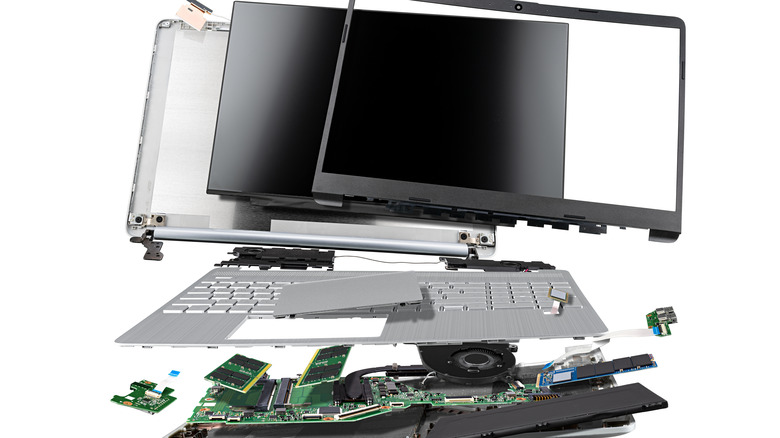Is It Safe To Remove Your Laptop's Display?
The entire point of a laptop computer is that it's both a display and a computer proper in a single, convenient package. However, while the display of a laptop is hard-connected to it via internal wires and hinges, that display is still technically a standalone device, in the same way that the monitor you connect your computer tower to is a standalone device. In theory, it's possible to completely remove that display from the overall laptop, and in doing so, you could create an ergonomic slabtop to minimize your space usage.
However, the big question is whether or not doing so is actually safe for your laptop. After all, in spite of all the aforementioned technicalities, that display is still connected to the rest of the laptop with solid connections and plastic, which means removing it would require some precise breakage. With all that in mind, you might wonder if you can remove your laptop's display in such a way that the leftover computer can still be used as normal.
Can the job be done?
The broad answer is yes, you can remove a laptop's connected display without hindering the rest of the device's ability to function. However, there are some major caveats associated with that confirmation. First and foremost, if you take the display off of your laptop, then obviously, it won't have a display. Most laptops feature external HDMI and display ports, separate from the internal connectors to the built-in display, so as long as you have a cable and a standalone monitor, you can send the laptop's signal there instead and use it as you would a traditional tower. This is also a good backup option if your laptop display breaks for whatever reason.
Secondly, if you remove the display from your laptop, the display itself may be rendered useless. Laptop displays are usually hard-wired to the laptop's internals, so if you disconnect those wires, the computer will be fine, but the display won't have any means of external connection. Unless you happen to be very talented with a soldering iron, there's no way to hook that removed display up to anything else.
Finally, depending on the make and model of your laptop, the display casing may have other important parts housed within it. This can include things like wireless receivers and optional ports. If you take the whole display out, those parts are going to go with it, which can severely impact your laptop's functionality.
Removing a laptop screen is a delicate procedure
Perhaps the most important thing to know when it comes to removing a display from a laptop is, well, how to remove the display from the laptop. Since displays are hard-wired, it's never as simple as just yanking the panel off from the lower portion.
To remove a laptop's display, you need to engage in an extremely complex disassembly procedure, up to and including completely disassembling the lower portion (keyboard, CPU, etc.). Only by disassembling the lower portion can you get at the screws and wires that hold the upper portion in place, and even then, the connections need to be very carefully undone, lest you risk breaking the whole thing.
So, in short, while it is technically possible to remove a laptop's display, it shouldn't be done unless you are 100% certain you know exactly how to. Otherwise, if you absolutely need to remove that display for some reason, just take it to a repair shop and let them do it.


